Preface
As teachers, we know that undergraduate science education is evolving. Simply conveying facts does not produce a scientifically literate student, a long-
Textbooks are an important part of the equation. A good textbook must now be more than a guide to the information that defines a discipline. For instructors, a textbook must organize information, incorporate assessment tools, and provide resources to help bring a discipline to life. For students, a textbook must relate science to everyday experience, highlight the key concepts, and show each student the process that generated those key concepts.
This book had its genesis at a meeting of the authors in Napa Valley in January 2006. From the outset, we set ambitious goals designed to address the key challenges we face as teachers.
Students see science as a set of facts rather than an active human endeavor. Molecular biology has a wealth of important stories to tell. We wanted to convey the excitement that drives modern molecular biology, the creativity at the bench, and the genuine wonder that takes hold as the workings of a new biological process are revealed. This theme is set in the first chapter, dedicated in large measure to an introduction to the scientific process. Every chapter then begins with a Moment of Discovery, highlighting a researcher’s own description of a memorable moment in his or her career. After Chapter 1, every chapter ends with a How We Know section, with stories relating the often circuitous path to a new insight. Additional anecdotes—
This second edition is an update, and much more. It has allowed us to refine the initial vision we had when we started this project and to augment that vision with unparalleled resources that will bring the subject to life for students and educators alike.
MOMENT OF DISCOVERY
Scientific breakthroughs represent the exhilarating culmination of a lot of hard work. Each chapter opens with a description of a significant breakthrough in molecular biology, told by the scientist who made the discovery. The scientists featured in the Moments of Discovery are David Allis, Norm Arnheim, Bonnie Bassler, Steve Benner, James Berger, Carlos Bustamante, Rose Byrne, Jamie Cate, Joe DeRisi, Roxana Georgescu, Lin He, Tracy Johnson, Melissa Jurica, Judith Kimble, Robert Lehman, Steve Mayo, Harry Noller, Smita Patel, Lorraine Symington, Jack Szostak, Robert Tjian, and Wei Yang.
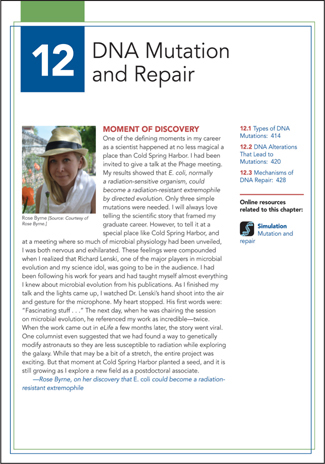
xxi
HOW WE KNOW
Each chapter ends with a How We Know section that combines fascinating stories of research and researchers with experimental data for students to analyze.
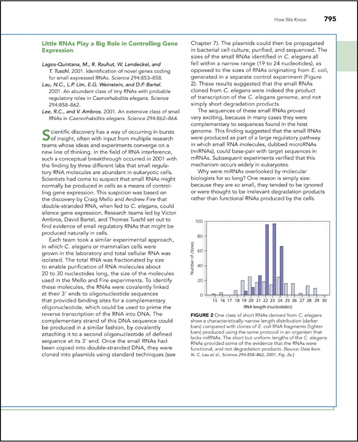
Students often view science as a completed story. The reality is far different. Data can take a researcher in unexpected directions. An experiment designed to test one hypothesis can end up revealing something quite different. The analysis of real data is a fundamental skill to be honed by every student of science. We have tried to address this need aggressively. Each chapter in this text features a challenging set of problems, including at least one requiring the analysis of data from the scientific literature. Many of these are linked to the discoveries described in the How We Know sections. Each chapter also ends with some Unanswered Questions, providing just a sampling of the endless challenges that remain for those with the motivation to tackle them.
UNANSWERED QUESTIONS
A short section at the end of each chapter describes important areas still open to discovery, showing students that even well-
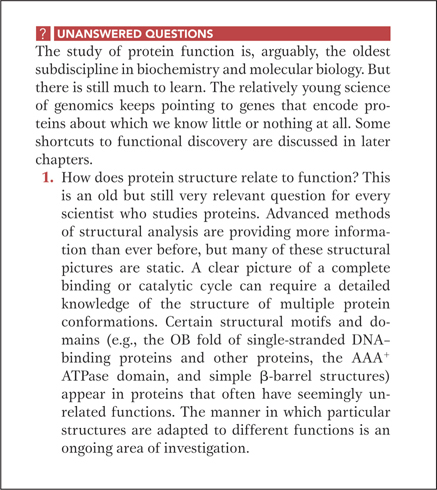
END-
Extensive problem sets at the end of each chapter give students the opportunity to think about and work with the chapter’s key ideas. New problems have been added in each chapter for this second edition. Each problem set concludes with a Data Analysis Problem, giving students the critical experience of interpreting real research data. Solutions to all problems can be found at the back of the book.
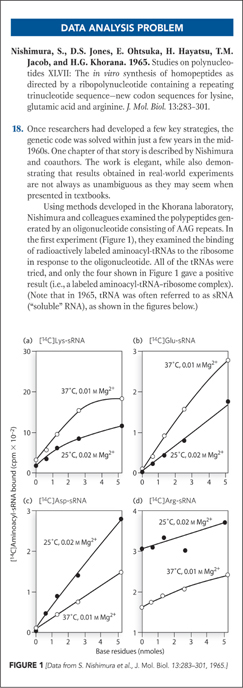
xxii
Students get lost in the details. Presenting the major concepts clearly, in the text as well as in the illustrations, is crucial to teaching students how science is done. We have worked to use straightforward language and a conversational writing style to draw students in to the material. We have collaborated closely with our illustrator, Adam Steinberg, to create clean, focused figures. Featured Key Conventions highlight the implicit but often unstated conventions used when sequences and structures are displayed and in naming biological molecules.
KEY CONVENTIONS
In brief paragraphs, the Key Conventions clearly lay out for students some fundamental principles often glossed over.

ILLUSTRATIONS
Good figures should speak for themselves. We have worked to keep our figures simple and the figure legends as brief as possible. The illustrations in the text are the product of close collaboration with our colleague Adam Steinberg. Together with the talented artists at Dragonfly Media Group, Adam has helped to hone and implement our vision.
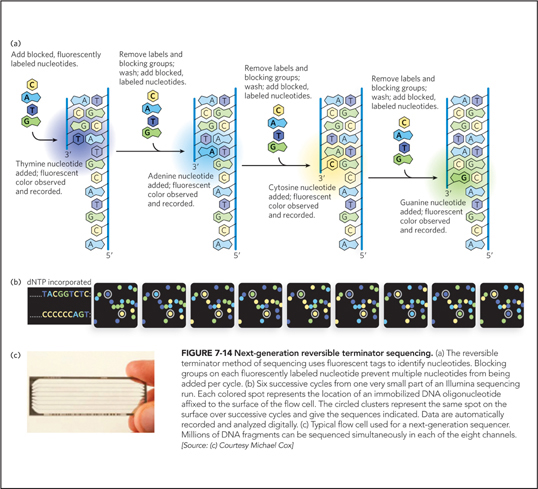
Students see evolution as an abstract theory. Every time a molecular biologist studies a developmental pathway in nematodes, identifies key parts of an enzyme active site by determining what parts are conserved among species, or searches for the gene underlying a human genetic disease, he or she is relying on evolutionary theory. Evolution is a foundational concept, upon which every discipline in the biological sciences is built. In this text, evolution is a theme that pervades every chapter, beginning with a major section in Chapter 1 and continuing as the topic of many Highlights and chapter segments.
HIGHLIGHTS
These discussions are designed to enhance students’ understanding and appreciation of the relevance of each chapter’s material. There are four categories of Highlights:
Medicine explores diseases that arise from defects in biochemical pathways, and how concepts uncovered in molecular biology have contributed to drug therapies and other treatments.
Technology focuses on cutting-
edge molecular biology methods. Evolution reveals the role of molecular biology research in understanding key biological processes and the connections among organisms.
A Closer Look examines a wide variety of additional, intriguing topics.
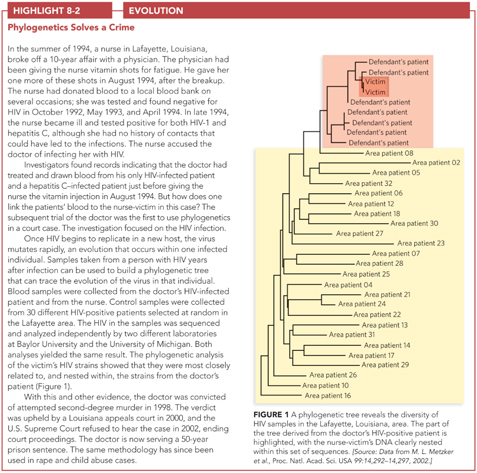
xxiii
EXPERIMENTAL TECHNIQUES
As researchers, we know that it is critical to understand the benefits and limitations of experimental techniques. We strive to give students a sense of how an experiment is designed and what makes the use of a particular technique or model organism appropriate. The techniques covered in this book are:
Ames test
Chemical modification interference
Chemical protection footprinting
Chemical synthesis of nucleic acids
ChIP-
ChIP-
Chromatography
Affinity chromatography
Using terminal tags
Using tandem affinity purification (TAP) tags
Column chromatography
Gel-
Ion-
Thin-
CRISPR/Cas
Detecting A=T-
DNA cloning
DNA cloning with artificial chromosomes (BACs, YACs)
DNA footprinting
DNA genotyping (DNA fingerprinting, DNA profiling, STR analysis)
DNA library creation (cDNA, genomic)
DNA microarrays
DNA sequencing
Automated Sanger sequencing
Deep sequencing
Genome sequencing techniques
Ion torrent
Next generation sequencing
Pyrosequencing
Reversible terminator sequencing
Sanger sequencing
Single molecule real time (SMRT) sequencing
Electrophoresis
Agarose gel electrophoresis
Isoelectric focusing
Pulsed field gel electrophoresis (PFGE)
Sodium dodecyl sulfate–
Two-
Electrophoretic mobility shift assay (EMSA)
Electroporation
Epitope tagging
Haplotype analysis
Immunoprecipitation
Linkage analysis
Localization of GFP fusion proteins
Mass spectrometry
Northern blotting
Nuclear magnetic resonance (NMR)
Optical trapping
Photolithography
Phylogenetic analysis
Phylogenetic profiling
Polymerase chain reaction (PCR)
Quantitative PCR (qPCR)
Reverse transcriptase PCR (RT-
Protein chips
Protein localization via indirect immunofluorescence
Recombinant protein expression
RNA interference (RNAi)
RNA-
Selection and screening
Site-
Somatic cell nuclear transfer (SCNT)
Southern blotting
Transformation
Western blotting
X-
Yeast three-
Yeast two-
NEW AND UPDATED CONTENT
The second edition addresses recent discoveries and advances, corresponding to our ever-
Chapter 1
Updated discussions of evolution and the scientific method
xxiv
Chapter 2
Updated discussion of the central dogma
Updated and expanded discussion of the types of RNA
Chapter 3
New Moment of Discovery
Expanded discussion of nucleosides
Revised and expanded section: The Hydrophobic Effect Brings Together Nonpolar Molecules
New section: Electronic Interactions between Bases in Nucleic Acids
Chapter 4
Expanded section: Amino Acids Are Categorized by Chemical Properties
Significantly expanded discussion of protein purification, including Highlight 4-
1 New section: Intrinsically Unstructured Proteins Have Versatile Binding Properties
Expanded section on protein families
Significantly expanded section on protein folding and computational biology
Chapter 5
New Moment of Discovery
Chapter 6
Expanded discussion of the instability of RNA
New Highlight 6-
1: DNA Nanotechnology New discussion of riboswitches
Chapter 7
Expanded discussion on obtaining DNA fragments to clone
Thoroughly updated section on next-
gen and other modern DNA sequencing technologies. New section: Genomic Sequencing Is Aided by New Generations of DNA Sequencing Methods, incorporating the exciting new advances with programmable nucleases
Chapter 8
Expanded Highlight 8-
1, now including discussion of the microbiome Updated section on noncoding DNA
Expanded section on mass spectrometry
Chapter 10
New Moment of Discovery
Significantly expanded discussion of histone modifications, including a new table
Chapter 11
Expanded discussion of the β sliding clamp
Expanded discussion of the Pol III holoenzyme
Updated and expanded discussion of eukaryotic replication forks
Updated and expanded section: Eukaryotic Origins “Fire” Only Once per Cell Cycle
New section: Telomeres and Telomerase Solve the End Replication Problem in Eukaryotes
New Highlight 11-
2: Short Telomeres Portend Aging Diseases
Chapter 12
New Moment of Discovery
New table presenting overview of DNA repair processes
Chapter 13
Updated and expanded sections on double-
strand break repair and reconstruction of replication forks Updated section on meiotic recombination
Chapter 14
Updated and expanded introductory section on transposable elements and site-
specific recombination Updated and expanded section: Precise DNA Rearrangements Are Promoted by Site-
Specific Recombinases Reorganized section on the use of site-
specific recombination systems in biotechnology Updated and expanded sections on transposition
Chapter 15
Updated section on transcription elongation
Updated and expanded discussion of the role of transcription factors
Updated and expanded discussion of termination mechanisms among RNA polymerases
Chapter 16
Streamlined chapter organization
Expanded discussion of P bodies
Chapter 18
Streamlined chapter organization
Updated discussion of protein release factors
Updated discussion of nuclear export signals
Chapter 19
Updated section: Gene Expression Is Regulated through Feedback Loops, now including inducer exclusion
Chapter 22
Expanded section on alternative splicing, including ESEs and ESSs
Updated section on RNA interference
New section: RNAs Regulate a Wide Range of Cellular Processes
Updated section on the developmental potential of stem cells
MEDIA
Simulations
One of our central goals in tackling the revision of this textbook was to provide special resources to engage students (and educators) in molecular biology. New to the second edition are simulations that cover core molecular biology concepts and techniques. Created using the art from the text, the simulations reinforce students’ understanding by allowing them to interact with the structures and processes they have encountered. A gamelike format guides students through the simulations, unlocking them in order, and multiple-
xxvi
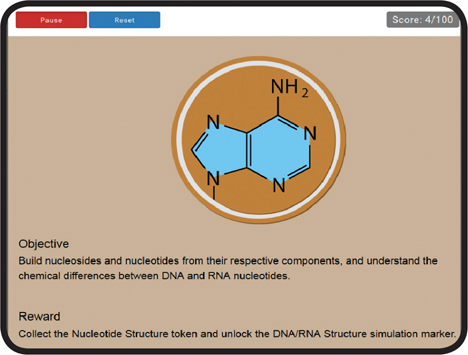
Nucleotide Structure (Chapter 3)
DNA/RNA Structure (Chapter 6)
PCR (Chapter 7)
Sanger Sequencing (Chapter 7)
CRISPR (Chapters 7 and 19)
DNA Replication (Chapter 11)
DNA Polymerase (Chapter 11)
Mutation and Repair (Chapter 12)
Transcription (Chapter 15)
mRNA Processing (Chapter 16)
Translation (Chapter 18)
Nature Articles with Assessment
These articles engage students in reading about primary research and encourage critical thinking. Specifically selected for both alignment with the text coverage and exploration of identified difficult topics, the Nature articles include assessment questions that can be automatically graded. Also included are open-
The simulations and Nature articles for Molecular Biology: Principles and Practice are available in our LaunchPad system, along with many additional resources.

This dynamic, fully integrated learning environment brings together all of our teaching and learning resources in one place. It also contains the fully interactive e-
New Clicker Questions allow instructors to integrate active learning in the classroom and to assess students’ understanding of key concepts during lectures.
Updated Test Bank contains at least 40 multiple-
 allows students to test their comprehension of the chapter concepts. The system adapts to students’ individual level of preparedness by giving them questions at varying levels of difficulty, depending on whether they answer a question without help, or they need help but eventually get the question right, or they are unable to answer the question. Links to the appropriate e-
allows students to test their comprehension of the chapter concepts. The system adapts to students’ individual level of preparedness by giving them questions at varying levels of difficulty, depending on whether they answer a question without help, or they need help but eventually get the question right, or they are unable to answer the question. Links to the appropriate e-
Key Term Flashcards allow students to review the definitions of all the glossary terms and quiz themselves.
Textbook Images and Tables are offered as high-
xxvii